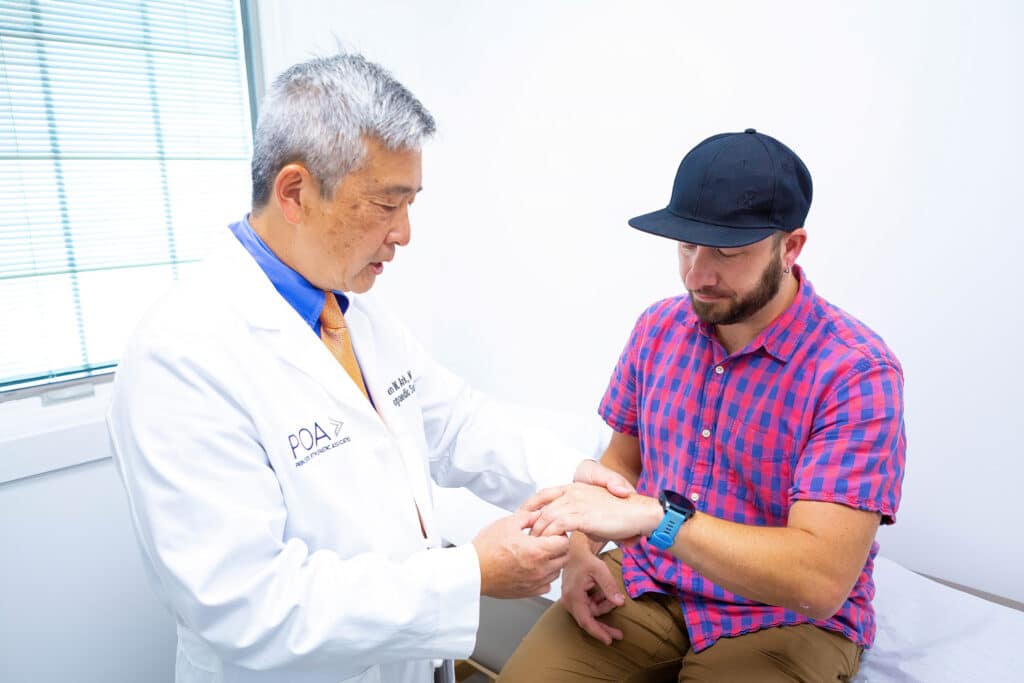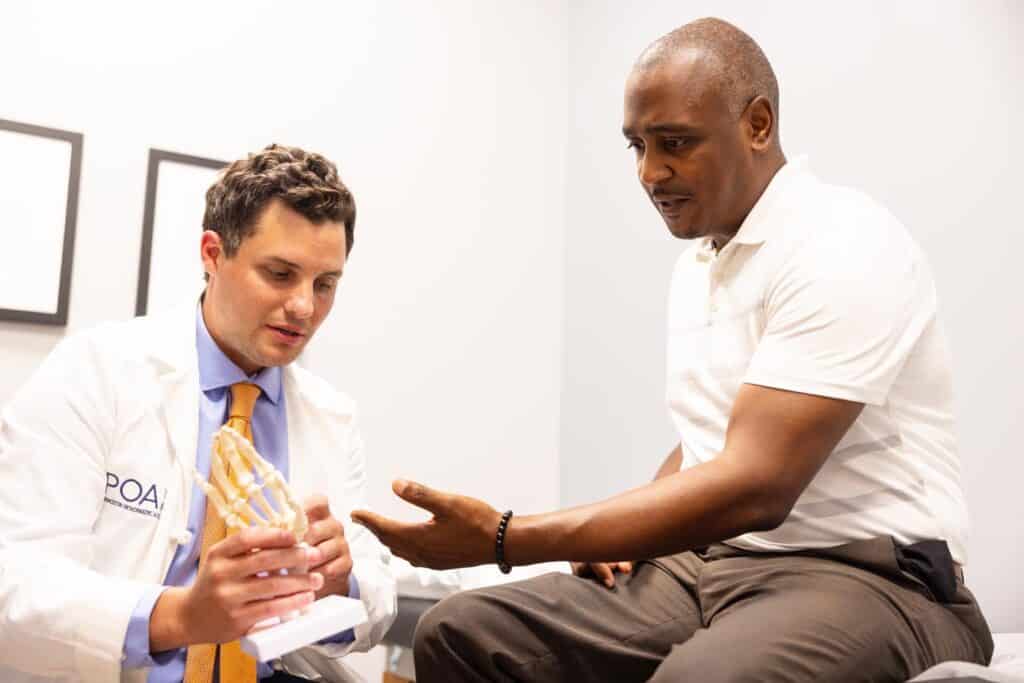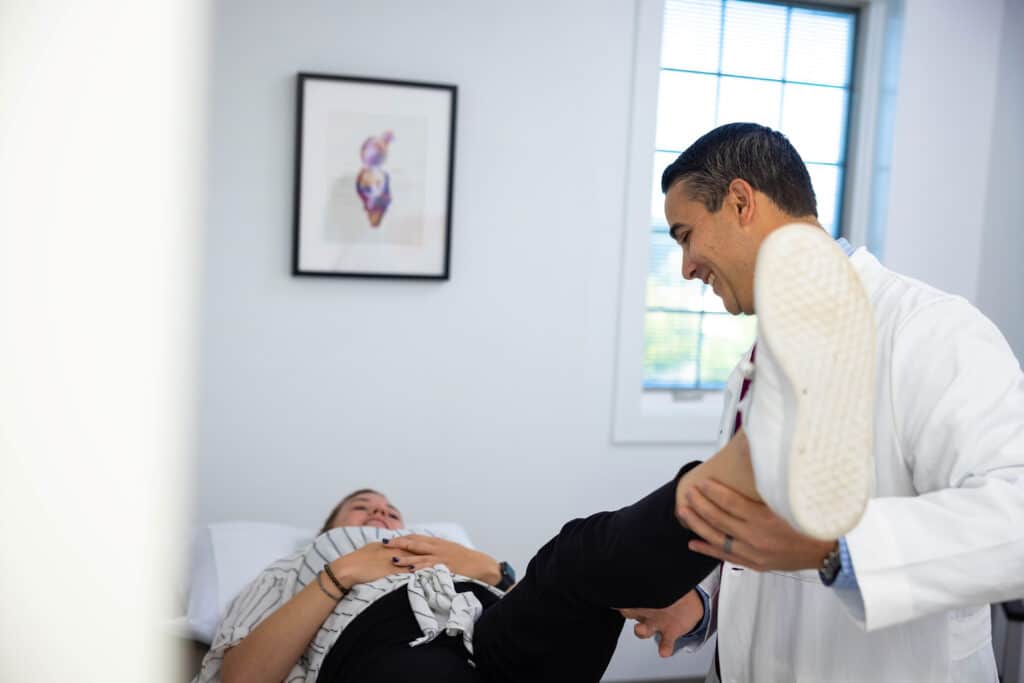
Physician Assistants
Physical & Occupational Therapists
KneeMRI ScansNon-OperativePhysiatry
Physical Therapy
Podiatry
Spine
Sports Medicine
TraumaUrgent Care
X-Ray Imaging


From simple tasks like typing on a keyboard to more complex activities like playing sports, our fingers are integral to almost everything we do. Whether it's the discomfort of trigger finger or the frustration of thumb twitching, these common issues can make even the simplest tasks challenging. Understanding their causes, symptoms, and available treatments is essential for effectively managing these conditions and returning to living without constant discomfort.
With how integral our hands are in our day-to-day activities, it's not surprising that there are problems that can arise.
It can be a bit scary if your finger gets stuck or locked in a position. This condition is known as Trigger Finger. Trigger finger is caused by the tendons in the finger becoming inflamed and thickened, making it difficult for the tendon to move smoothly through its sheath. This can result in the finger getting stuck in a bent position, accompanied by pain, stiffness, and a popping or clicking when moving the finger. For more information, see our blog on trigger finger.
If you have a twitching thumb, it may be a condition called Thumb Twitching. This is involuntary movements of twitches in the thumb. This can be caused by overuse of the thumb muscles, stress, fatigue, or underlying neurological conditions such as carpal tunnel syndrome or nerve compression. It often presents with weakness, tingling, or numbness in the thumb.



Numbness in fingers can be indicative of Carpal Tunnel Syndrome. This condition is caused by compression of the median nerve in the wrist and can lead to numbness, tingling, weakness, or pain in the thumb, index, middle, and half of the ring finger. It may be exacerbated by repetitive motions, injury, or underlying health conditions like arthritis. Learn more from our Carpal Tunnel Syndrome 101 blog.

Sometimes inflammation of the joints in your fingers can be caused by Arthritis, either Osteoarthritis or Rheumatoid Arthritis. Arthritis is inflammation of the joints that can affect your fingers and thumb. Osteoarthritis results from degenerative changes in joint cartilage. Rheumatoid arthritis is an autoimmune condition that causes joint inflammation. Symptoms include joint pain, stiffness, swelling, and reduced range of motion. Learn more about Hand Arthritis.
That wasn't a typo! Stiff fingers can also be caused by Tendonitis. How do you tell the difference? As mentioned above, the root of stiff fingers with Arthritis is inflammation of the joints. Tendonitis is inflammation of the tendons, often due to overuse, repetitive motions, or injury. It commonly presents with pain, swelling, tenderness, or warmth around the affected tendon, along with limited mobility.
If your fingers won't straighten it may be Dupuytren's Contracture, a condition characterized by the thickening of tissue in the palm, leading to fingers being pulled into a bent position. The cause is often unknown but may involve genetic factors, injury, or certain medical conditions. It can result in finger stiffness and an inability to fully straighten the fingers.
De Quervain's Tenosynovitis is inflammation of the tendons at the base of the thumb. It typically occurs due to overuse, repetitive thumb movements, or direct injury. Symptoms include pain, swelling, and tenderness at the base of the thumb, often accompanied by difficulty gripping or pinching.
Ganglion Cysts are non-cancerous lumps or masses that typically form along the tendons or joints of the wrist or fingers. The cause is often unclear, but they may result from joint or tendon irritation, trauma, or unknown factors. Symptoms include pain or discomfort and a visible lump that may interfere with movement. Read more about Understanding Ganglion Cysts.

Please contact us! We'd love to help.
If you have pain, please contact us and schedule an appointment. We have urgent care facilities all over New Jersey for your convenience.
Mallet Finger, also known as Baseball Finger, is caused by an injury to the extensor tendon at the tip of the finger, leading to an inability to fully straighten the fingertip. This often happens due to direct trauma or forceful impact, such as during sports activities.
Jersey Finger is not something that can only happen in New Jersey. Jersey Finger is an injury to the flexor tendon in the finger, typically occurring when forcefully trying to extend the finger while it is flexed. This can happen during sports or physical activities and results in an inability to flex the finger at the distal joint.
These finger conditions, from trigger finger to arthritis, can disrupt your daily routine and cause significant discomfort. While mild cases may respond well to at-home treatments such as rest, ice, splinting, and over-the-counter pain medications, more severe or persistent symptoms may require intervention from an orthopedic surgeon.
If you experience persistent pain, swelling, or difficulty performing everyday tasks despite home remedies, it's crucial to seek help from a specialist. Our orthopaedic hand specialists will provide a thorough evaluation, diagnosis, and a tailored treatment plan to address your specific needs. Don't let finger problems hold you back from enjoying life to the fullest. Take your first step towards relief and contact us to schedule today. Your fingers will thank you!
This blog post is meant to be informative and should not act as a self-diagnosis tool. If you’d like to see one of our doctors, please contact us here.
Whether you're experiencing discomfort in your hips due to inflammation or swelling, understanding this condition is vital to finding relief. Understanding the symptoms, causes, and treatment options for hip bursitis empowers you to take control of your health and well-being.

Hip bursitis, a form of arthritis, occurs when the bursa, fluid-filled sacs that cushion your joints, become inflamed and angry. Repetitive activities or injuries often cause it because this can result in pain and swelling around the hips, making everyday activities challenging. The result? Pain, tenderness, and swelling around your hip area. The first sign? Sharp pain at first that can settle into a nagging ache over time. Watch for swelling, warmth, and even redness around your hip.

Hip bursitis can develop from various factors:
Understanding the underlying causes can aid in prevention and management strategies. Think of hip bursitis as your body's way of saying "ouch" to alert you to overuse, injury, or poor posture. Even getting older can make you more prone to hip bursitis. Understanding the triggers can help you prevent future episodes. It's like your body's saying, "Hey, take it easy!"
Recognizing the symptoms of hip bursitis is essential for early intervention. Hip bursitis isn't shy about letting you know it's there.
If you are feeling pain, tenderness, or swelling around your hip, especially when you move, it might be hip bursitis.

Other signs include:
From pain and tenderness to swelling and altered gait, understanding these signs can help you seek timely treatment.
Hip bursitis isn't shy about making itself known. Activities like lying down for too long or walking distances can further irritate the bursa, adding "fuel to the fire." Some exercises and certain conditions, like rheumatoid arthritis or poor posture, can exacerbate hip bursitis, so keeping these in check is essential.
Managing hip bursitis involves a multifaceted approach to reducing inflammation and promoting healing. So, what can you do about it?
Fortunately, there are a few things you can implement yourself to find relief:
Resting the affected hip is crucial for reducing inflammation and promoting healing. Avoid activities that exacerbate pain and discomfort.
Heat therapy, such as warm compresses or heating pads, can help relax muscles. It can increase blood flow to the affected area, promoting healing and soothing pain.
Applying ice packs to the painful area can help reduce swelling and alleviate pain. Ice therapy can be done several times a day for about 15-20 minutes.
Over-the-counter pain relievers such as ibuprofen (Advil, Motrin) or naproxen (Aleve) can help alleviate pain and reduce inflammation.
Eating healthily and staying active can also help manage hip bursitis. Resting gives your hip a chance to recover, while a balanced diet supports overall healing. Stay active, but don't overdo it! If the pain persists, consult with an orthopaedic specialist for a tailored treatment plan.
There are other treatments your doctor may recommend for relief, such as:
Addressing hip bursitis with physical therapy gives you the advantage of tailored exercises that can work wonders, strengthening your hip and easing discomfort. Seeing a trained physical therapist is essential because knowing which exercises to avoid is just as crucial as knowing which ones to embrace.
Prevention is the key when it comes to hip bursitis.
Simple lifestyle changes, such as maintaining a healthy diet, regular exercise, and correcting posture, can help prevent the recurrence of this painful condition.
They say prevention is the best medicine, and it's true for hip bursitis too.
Early intervention is key to healing hip bursitis. Ice packs and rest can kickstart the process, followed by a visit to an orthopedic specialist for tailored guidance. If you feel like you're experiencing hip bursitis without relief, reach out and make an appointment with one of our orthopaedic specialists.

Please contact us! We'd love to help.
If you have hip pain, please contact us and schedule an appointment. We have urgent care facilities all over New Jersey for your convenience.
If you are experiencing hip bursitis, there are some specific things to avoid. Avoid things like running, deep squats, and leg lifts. Even cardio machines can be a no-go because they put too much pressure on your already irritated hips. Instead, focus on gentle stretches and movements that support rather than strain your hip joints.
Dealing with hip bursitis can be challenging, but it's not something you have to put up with forever; relief is within your reach with the proper knowledge and proactive steps. By understanding hip bursitis and its causes, recognizing its symptoms, and knowing how to address it effectively, you can manage it and get back to feeling like yourself again. Don't let hip bursitis hold you back.
This blog post is meant to be informative and should not act as a self-diagnosis tool. If you’d like to see one of our doctors, please contact us here.
